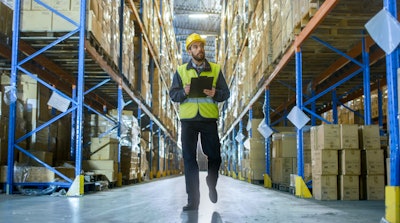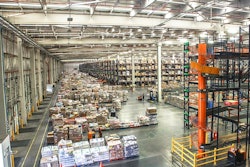If anything can be said about warehouse management systems (WMS) in 2018, it was a year when warehouse managers took stock of new market pressures and demands, looked at how they were executing on the floor, and determined that new approaches were needed.
While there are many warehouses across the country that still operate on a largely manual basis, the impacts of labor shortages, the need to track and trace products from origin to final destination, requests for 24/7 operations in a variety of geographic locales that are both foreign and domestic, and the need to meet product demands but not carry excess inventory formed a formidable list of pressures that warehouse managers had to address.
“In 2018, we saw more distributors move beyond the warehouse and also start running their own trucks,” says Fran Rifkin, WMS product manager for AFS Technologies, which provides systems for consumer goods and food and beverage companies. “We’ve added yard operations to the WMS system to expand visibility of the truck loading process. This enables managers to plan the loads of trailers, which they can do with drag and drop load-planning tools. Pickers and loaders also know the sequence of how each trailer load should be done. This really helps the driver, and it also makes pallet traceability easier. The bottom line for warehouse managers is that they have more control over a larger part of the process. In the past, the warehouse’s role might have been just loading the pallets at the door for pickup.”
If anything can be said about warehouse management systems (WMS) in 2018, it was a year when warehouse managers took stock of new market pressures and demands, looked at how they were executing on the floor, and determined that new approaches were needed.
While there are many warehouses across the country that still operate on a largely manual basis, the impacts of labor shortages, the need to track and trace products from origin to final destination, requests for 24/7 operations in a variety of geographic locales that are both foreign and domestic, and the need to meet product demands but not carry excess inventory formed a formidable list of pressures that warehouse managers had to address.
“In 2018, we saw more distributors move beyond the warehouse and also start running their own trucks,” says Fran Rifkin, WMS product manager for AFS Technologies, which provides systems for consumer goods and food and beverage companies. “We’ve added yard operations to the WMS system to expand visibility of the truck loading process. This enables managers to plan the loads of trailers, which they can do with drag and drop load-planning tools. Pickers and loaders also know the sequence of how each trailer load should be done. This really helps the driver, and it also makes pallet traceability easier. The bottom line for warehouse managers is that they have more control over a larger part of the process. In the past, the warehouse’s role might have been just loading the pallets at the door for pickup.”
Of course, scaling out the warehouse also means scaling out operations and how you perform them.
In 2018, Rifkin says her firm saw customers requesting more voice-based applications so they could operate hands-free in freezers and other areas of the warehouse.
“They wanted to avoid taking off gloves,” she adds. “As a result, more customers were moving to voice for order selection. They have found the hands free operation very efficient and are also employing it in other areas of the warehouse…We’re additionally seeing voice-based technology being extended to loading and cycle-count operations.”
More voice-based order packing and warehouse operations weren’t the only thing customers were looking at in 2018. Additional WMS customer areas of interest were:
- Mobile technology and wearables
- Cloud-based systems
- Robots and other forms of automated equipment
- Better ability to track and trace goods inside and outside of the warehouse
- Smart barcodes
- Artificial intelligence and analytics
- The ability to run 24/7 operations in multiple geographies.
Key WMS Breakthroughs
For WMS vendors and their customers, the good news was that WMS was already a mature system, so there was firm bedrock to expand from. What we saw, then, in 2018 was a steady stream of enhancements that extended WMS capability.
One major enhancement area was moving more WMS functionality into browser-style screens and pushing out more functions to mobile devices that could be operated from anywhere.
“With mobile enablement, many WMS operations can be done from a desktop computer, but also from an RFID reader or a scanner,” explains Rifkin. “Warehouse employees can look up information such as the real-time status on a load and if the load can be closed out so the driver can get under way. You no longer have to walk back to the office to do this. You can also take pictures of merchandise as proof of no damage to the vendor when each shipment leaves.”
Equally important was a steady migration from in-house server-based systems to the cloud, driven by a need for many warehouse operations to be online 24/7.
With the cloud, warehouse managers no longer have to worry about a server crash and how to get operations back online. A cloud provider can do this for you. Also with the cloud, there are built-in fail-over systems and an ability to run a chain of warehouses that could be located around the world.
Closely related to this was a need to localize WMS systems in a variety of different languages. Responding to this need, Oracle announced in 2018 that its WMS was localized in 10 different languages.
Finally, barcode technology, along with much needed best practices, continued to make progress and be integrated into WMS systems.
Warehouse operators are now using both 1D and 2D barcodes with their WMS systems. The linear 1D barcodes make up UPC labels and are handy because they can easily be changed as the price on a given item changes.
An alternate option is the 2D barcode, which carries more information, including photos, instructions, website addresses and voice-based data. However, this denser data mass can’t be as readily changed as 1D barcodes. Where 2D barcodes excel are in complex supply chains and on products like medical equipment.
Looking Ahead
Over the next two or three years, more automation, Internet of Things (IoT) technology and artificial intelligence (AI) will make its way into warehouses. Here are a few examples of how:
Use of robots, drones
and automated conveyor systems
Robotic forklifts are already taking over some of the heavy lifting and warehouse traffic that humans used to do. And while drones have stalled as a means of delivering shipments in the United States, they are being used inside of large warehouses to check stock levels and patrol the premises. Additionally, automated conveyor systems are being used to move goods from Point A to Point B. The automated conveyor systems combine with robots that are trained by humans to perform goods packaging.
IoT solutions for
track and trace
Product quality, operational efficiencies and regulatory requirements will continue to drive IoT adoption and smart labels for product tracking and traceability. The ability to track and trace becomes more important as companies with warehouses decide to also enter into outbound and inbound logistics. The tracking and tracing functionality will be able to integrate with WMS systems so that managers have an interrupted picture of product movement to the warehouse, within the warehouse, and back out of the warehouse to end destinations.
Better integration
in the cloud
Cloud WMS vendors will continue to make it easier for companies to add new functionality such as inbound and outbound logistics, whether it is through tacking on new logistics modules or expanding WMS.
Analytics and
artificial intelligence
Far and away the biggest player in WMS evolution over the next couple of years will be automated decision-making and analysis of data. Large payloads of data will continue to stream into WMS systems from traditional system transactions and from the IoT world in the form of sensor input, RFID input, barcode input and more.
As these massive amounts of data accumulate, the ability of computers to rapidly process them and serve up actionable insights will become a critical element in warehouse operations and strategy setting.
“With the expansion of artificial intelligence and analytics in warehouse operations, it’s important for customers to be able to access and summarize data,” says Rifkin. “For this to happen effectively, information has to be presented in meaningful ways.”
An example is the slotting of warehouse activities, where seasonality and velocity of product consumption play key roles. If your AI can give you predictions and recommendations on when to ramp up and when to ramp down, the warehouse can be operated more efficiently.
An Evolutionary Process
In the future, warehouse management systems will become more flexible and “pluggable” than ever before.
These systems will be able to interface with different ERP systems—and they will also be capable of running in a standalone mode for companies that don’t use ERP.
WMS systems will also continue to move to the cloud, where vendors will update them more frequently so companies can more rapidly use new innovations. Future versions of WMS will interact more readily with IoT, automation and robotics and will continue to transform warehouses. The AI offered through WMS what-if scenario modeling and a plethora of other analytics options will assist in warehouse management.
“This is an evolutionary process,” says Rifkin. “Before WMS, companies didn’t have defined and repeatable processes in the warehouse. What WMS did was force them to come up with processes and tame the ways they used to work. It helped them understand that they had to have processes.
“Now that the WMS processes are in place, there is a new level of engagement. The goal today is to transform these processes into more efficient workflows through the use of voice-based technology, smart labels, sensors, AI and mobile technology,” she adds. “Rapidly, WMS enhancements are moving warehouse operations away from warehouse workers having to memorize item locations, where they can potentially pick an item from a wrong location. Now, the system can tell them in real time what the correct item location is.”






![Img 2088[1]](https://img.foodlogistics.com/files/base/acbm/fl/image/2018/11/IMG_2088_1_.5bed972d77002.png?auto=format%2Ccompress&fit=crop&h=167&q=70&w=250)













